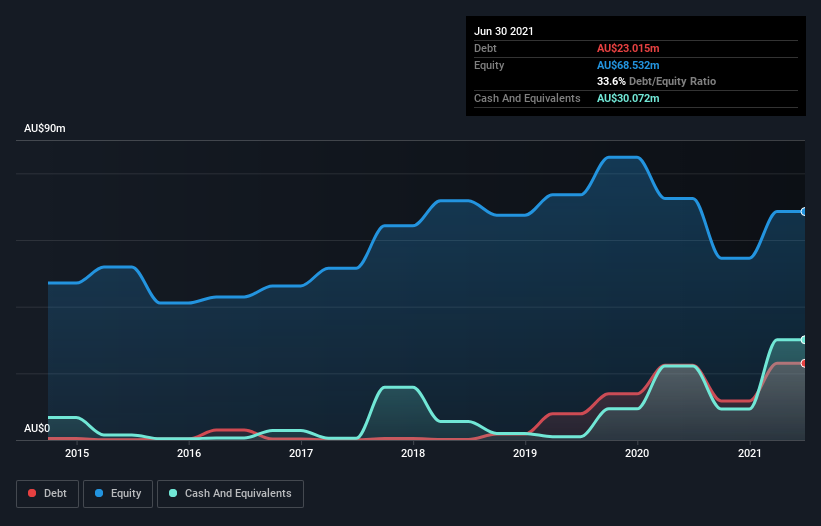Is Clean Seas Seafood (ASX:CSS) Using Debt Sensibly?
Howard Marks put it nicely when he said that, rather than worrying about share price volatility, 'The possibility of permanent loss is the risk I worry about... and every practical investor I know worries about.' When we think about how risky a company is, we always like to look at its use of debt, since debt overload can lead to ruin. Importantly, Clean Seas Seafood Limited (ASX:CSS) does carry debt. But should shareholders be worried about its use of debt?
When Is Debt Dangerous?
Generally speaking, debt only becomes a real problem when a company can't easily pay it off, either by raising capital or with its own cash flow. Ultimately, if the company can't fulfill its legal obligations to repay debt, shareholders could walk away with nothing. However, a more frequent (but still costly) occurrence is where a company must issue shares at bargain-basement prices, permanently diluting shareholders, just to shore up its balance sheet. Of course, the upside of debt is that it often represents cheap capital, especially when it replaces dilution in a company with the ability to reinvest at high rates of return. When we think about a company's use of debt, we first look at cash and debt together.
See our latest analysis for Clean Seas Seafood
What Is Clean Seas Seafood's Debt?
As you can see below, Clean Seas Seafood had AU$23.0m of debt, at June 2021, which is about the same as the year before. You can click the chart for greater detail. However, its balance sheet shows it holds AU$30.1m in cash, so it actually has AU$7.06m net cash.
A Look At Clean Seas Seafood's Liabilities
According to the last reported balance sheet, Clean Seas Seafood had liabilities of AU$22.2m due within 12 months, and liabilities of AU$11.3m due beyond 12 months. Offsetting these obligations, it had cash of AU$30.1m as well as receivables valued at AU$6.38m due within 12 months. So it actually has AU$2.99m more liquid assets than total liabilities.
This short term liquidity is a sign that Clean Seas Seafood could probably pay off its debt with ease, as its balance sheet is far from stretched. Succinctly put, Clean Seas Seafood boasts net cash, so it's fair to say it does not have a heavy debt load! There's no doubt that we learn most about debt from the balance sheet. But ultimately the future profitability of the business will decide if Clean Seas Seafood can strengthen its balance sheet over time. So if you want to see what the professionals think, you might find this free report on analyst profit forecasts to be interesting.
Over 12 months, Clean Seas Seafood reported revenue of AU$50m, which is a gain of 24%, although it did not report any earnings before interest and tax. Shareholders probably have their fingers crossed that it can grow its way to profits.
So How Risky Is Clean Seas Seafood?
By their very nature companies that are losing money are more risky than those with a long history of profitability. And the fact is that over the last twelve months Clean Seas Seafood lost money at the earnings before interest and tax (EBIT) line. Indeed, in that time it burnt through AU$13m of cash and made a loss of AU$32m. Given it only has net cash of AU$7.06m, the company may need to raise more capital if it doesn't reach break-even soon. With very solid revenue growth in the last year, Clean Seas Seafood may be on a path to profitability. Pre-profit companies are often risky, but they can also offer great rewards. The balance sheet is clearly the area to focus on when you are analysing debt. However, not all investment risk resides within the balance sheet - far from it. We've identified 3 warning signs with Clean Seas Seafood , and understanding them should be part of your investment process.
Of course, if you're the type of investor who prefers buying stocks without the burden of debt, then don't hesitate to discover our exclusive list of net cash growth stocks, today.
This article by Simply Wall St is general in nature. We provide commentary based on historical data and analyst forecasts only using an unbiased methodology and our articles are not intended to be financial advice. It does not constitute a recommendation to buy or sell any stock, and does not take account of your objectives, or your financial situation. We aim to bring you long-term focused analysis driven by fundamental data. Note that our analysis may not factor in the latest price-sensitive company announcements or qualitative material. Simply Wall St has no position in any stocks mentioned.
Have feedback on this article? Concerned about the content? Get in touch with us directly. Alternatively, email editorial-team (at) simplywallst.com.

 Yahoo Sport
Yahoo Sport 






































